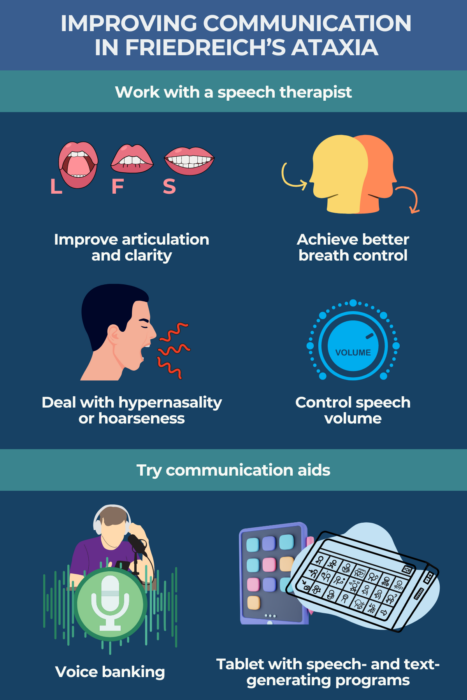How speech therapy and voice banking can help people with FA
Last updated Aug. 22, 2024, by Susie Strachan

Friedreich’s ataxia (FA) causes a loss of control over voluntary movements due to muscle weakness, including in the muscles you use for speaking. FA speech can be slow or slurred (a speech disorder called dysarthria), making it hard for you to communicate.
FA speech therapy can help you improve pronunciation, control the volume of your voice, and better regulate your breathing.
In addition to speech therapy, using voice banking services to record your speech and augmentative and alternative communication devices, such as tablets and communication boards, can make communicating easier.
How FA affects speech
Along with other symptoms of FA, you might notice the muscles of your tongue, lips, and jaw become weaker over time.
Dysarthria is a core symptom of FA. It affects the clarity of your words, the rate and rhythm of your speech, and your ability to control your vocal pitch and loudness when speaking.
It can make it difficult to be understood, especially when talking on the phone or in a place that is noisy.
FA speech problems can be frustrating and stressful. Speech issues can make it harder to express your thoughts, emotions, and needs.
Keep in mind that FA speech problems progress gradually. By starting speech therapy sooner, you may be able to maintain your ability to speak for longer and adapt to other ways of communicating.
To help you come to terms with these changes and feelings, you may want to consider therapy or counseling.
Potential benefits of speech therapy
Your primary healthcare provider can refer you for evaluation by a speech language pathologist, also called a speech therapist, who will evaluate your speaking abilities and monitor them with regular assessments.
Some communication strategies you may learn from a speech therapist include:
- improving your articulation, clarity, and volume of speech
- maintaining adequate breath support for longer phrases and sentences
- addressing hoarseness or hypernasality (makes it sound like you’re speaking through your nose)
- monitoring your speech quality and identifying strategies to improve speech.
A speech therapist also can help manage symptoms of slow and slurred speech. They may show you exercises that help you:
- pronounce words with multiple syllables
- pronounce consonants
- control the loudness or quietness of your voice
- reduce your rate of speech
- achieve better breath control
- increase the strength of your jaw, tongue, and throat.
What is voice banking?
Voice banking is when you record your speech to create a personal digital voice.
After you record common phrases, sentences, and sounds, the voice bank creates a synthetic voice that closely resembles your natural voice. It should capture your unique intonations, pauses, and rhythm of speech.
Eventually, you may want to use speech-generating devices for communicating. Your digital voice can be a way to express your personal identity and support your emotional connection with family and friends.
You may want to do voice preservation early on, while you retain the ability to speak naturally, so you have the most accurate representation of your voice.
If you have questions about the voice banking process, a speech therapist can guide you.
You might also want to reach out to FA associations in your region for resources and support, including finding out more about voice banking services.

Combining speech therapy and voice banking
As FA progresses, speech therapy and voice banking can be used together to preserve your unique voice and communication skills.
While helping you improve your speaking ability and voice preservation, a speech therapist also can prepare you for voice banking by working on your vocal exercises and strengthening muscles used for speaking.
Together, you can also make updates to your voice bank recordings when needed.
A speech therapist can help you become familiar with the various FA communication aids, especially ones incorporating your synthetic voice.
Augmentative and alternative communication
Augmentative and alternative communication (AAC) resources include everything from using facial expressions, pen and paper, or sign language to trying more advanced tools like speech-generating devices and eye-tracking technology.
Eye-tracking devices help you control a computer or communication device with your eye movements, while speech-generating devices are controlled by a touchscreen, keyboard, or eye-tracking technology to produce spoken words, including from your voice bank.
Figuring out which FA communication aids to use depends on many factors, including the degree of your speech problems and any other FA physical challenges you are dealing with, such as issues with hand coordination or vision.
Your speech therapist can suggest ways to work around FA symptoms by helping you select and learn to use different AAC methods and tools, which might include:
- larger buttons or voice-activated controls to help with hand coordination issues
- picture boards or text-to-speech apps to help with speaking clearly.
Resources and support
To locate and select a qualified speech language pathologist, start by asking for referrals from your FA healthcare team.
Your primary care provider or neurologist should be able to recommend speech therapists who are experienced in treating people living with FA.
You can also look for therapists who are members of professional organizations such as the American Speech-Language-Hearing Association or the umbrella organization European Speech and Language Therapy Association.
National and international organizations and support groups for FA also may be able to help you locate speech therapy services. Check with:
- National Ataxia Foundation and its support groups
- Friedreich’s Ataxia Research Alliance (FARA) and its parent support group
- Canadian provincial ataxia support groups
- UK ataxia support groups.
When screening a potential speech therapist, it’s a good idea to ask if they are familiar with the challenges of FA and how it affects speech.
Also remember to check if your health insurance covers the treatment, including the cost of co-pays, and if the speech pathologist accepts your insurance.
Other questions you may want to to ask:
- How will you tailor therapy to my specific needs and symptoms?
- What are your strategies for addressing the physical challenges of FA that might affect therapy?
- Do you provide training and ongoing support for recommended AAC tools or devices?
- How will you measure and track my progress?
- How will you work with other members of my FA healthcare team?
Friedreich’s Ataxia News is strictly a news and information website about the disease. It does not provide medical advice, diagnosis, or treatment. This content is not intended to be a substitute for professional medical advice, diagnosis, or treatment. Always seek the advice of your physician or other qualified health provider with any questions you may have regarding a medical condition. Never disregard professional medical advice or delay in seeking it because of something you have read on this website.
Recent Posts
- My FA diagnosis left me ‘thoroughly shaken,’ but I’ve found my resolve
- New MRI approach using AI may offer better picture of FA changes
- Building and maintaining friendships is an intentional act
- Using technology in an FA household to enhance care
- A getaway makes me realize FA has created a creature of comfort
Related articles




